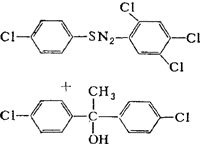Acaricides
chemical agents used to combat mites. Most effective against the herbivorous mites are the organophos-phorus insecticides (metaphos, methylnitrophos, trichlor-metaphos, and others) and, in particular, the so-called systemic insecticides (phosphamidon, methylmercaptophos, octamethyl pyrophosphoramide, and others), which make it possible to protect the plants for a protracted period. Also effective as acaricides are aromatic alcohols, esters of acids, sulfides, sulfones, azobenzene, nitrophenols, and certain organic compounds of fluorine, as well as sulfur preparations (in a ground form, as colloidal preparations, or in the form of calcium or barium polysulfides obtained by dissolving sulfur in lime; such a solution is known as lime-sulfur spray). Organophosphorus and organochlorine insecticides, carbamates, and others are used for combating ixodoid ticks.
Some acaricides are given in Table 1.
REFERENCES
Berim, N. G. Khimicheskaia zashchita rastenii. Leningrad, 1966.Mel’nikov, N. N. Khimiia pestitsidov. Moscow, 1968.
N. N. MEL’NIKOV
| Table 1 | |||
|---|---|---|---|
| Name | Formula | Melting temperature(°c) | Dos (kglha) |
| 1 Boiling point at absolute pressure of 8 newtons per square meter (0.06 mm of mercury) | |||
| Kelthane ............................... |  | 78.5–79 | 0.2–0.6 |
| Milbex ................................. |  | 123.5–124: 69.5–70 | 0.5–1.0 |
| Tedion (tetradichlon) .................... |  | 146.5–147.5 | 0.7–1.5 |
| Chlorbenside (chlorparacide) ............. |  | 72 | 0.2–0.6 |
| Chlorobenzilate ......................... |  | 141–142 | 0.2–0.8 |
| Chlorophenylchlorobenzenesulfonate (Ovotran) ............................ |  | 86.5 | 0.5–1.0 |